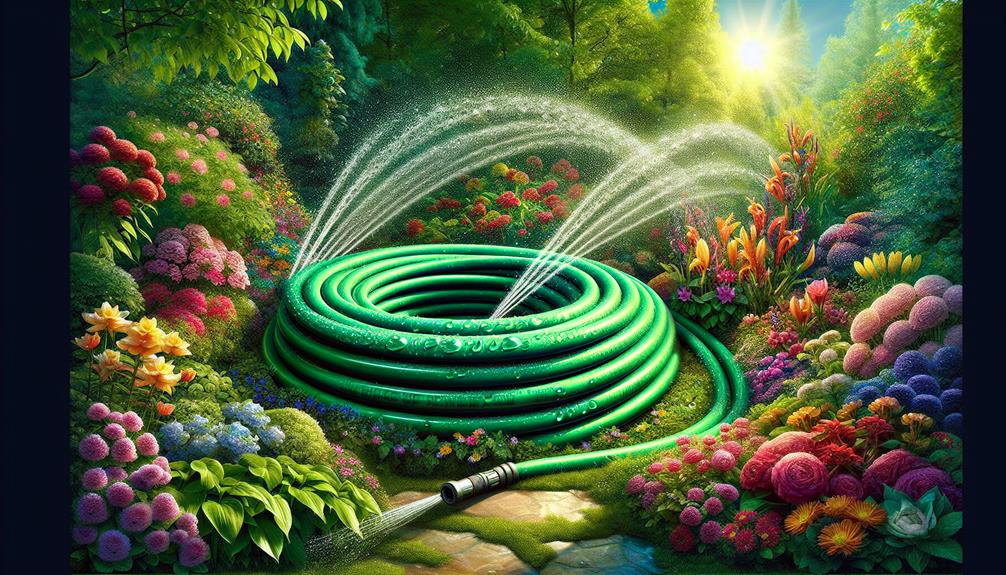Garden hoses are an essential tool for any gardener or homeowner with outdoor space. From watering plants to cleaning outdoor surfaces, the garden hose serves a variety of purposes.
However, not all garden hoses are created equal, and choosing the right one can make a significant difference in the efficiency and effectiveness of your outdoor tasks. Understanding the different types of garden hoses available, their benefits, and how to properly maintain them can help ensure that your gardening and cleaning routines run smoothly.
Stay tuned to discover valuable tips for selecting, using, and extending the lifespan of your garden hose.
Key Takeaways
- Choose the right hose based on length, diameter, and material for optimal performance.
- Proper maintenance like regular cleaning and storage ensures longevity.
- Select a hose suitable for your watering needs and climate to enhance durability.
- Store the hose properly to prevent damage and maximize its lifespan.
Types of Garden Hoses
When selecting a garden hose, consider the various types available to ensure optimal performance and durability. The most common types of garden hoses include vinyl, rubber, and reinforced hoses.
Vinyl hoses are lightweight and budget-friendly, making them suitable for light watering tasks. Rubber hoses are more durable and flexible than vinyl, able to withstand hot water and harsh weather conditions. Reinforced hoses, such as those made of rubber and reinforced with mesh lining, are the most durable and kink-resistant options available, ideal for heavy-duty watering needs.
Another consideration when choosing a garden hose is the diameter. Hoses typically come in 1/2-inch, 5/8-inch, and 3/4-inch diameters. A larger diameter allows for higher water flow, making it suitable for tasks that require a higher volume of water, like watering large gardens or washing vehicles.
Additionally, hoses come in various lengths, ranging from 25 to 100 feet, providing flexibility based on the size of your outdoor space. By selecting the right type, diameter, and length of garden hose, you can ensure efficient and effective watering for your plants and outdoor cleaning needs.
Benefits of Using a Garden Hose
Using a garden hose offers numerous advantages in maintaining your outdoor spaces efficiently and effectively. Here are some benefits of incorporating a garden hose into your gardening routine:
- Convenience: With a garden hose, you can easily water your plants, clean outdoor surfaces, and fill up pools or fountains without the need to constantly refill a watering can or carry heavy buckets back and forth.
- Versatility: Garden hoses come in various lengths and materials, allowing you to choose one that suits your specific needs. Whether you have a small balcony garden or a vast backyard, there is a garden hose suitable for your space.
- Time-saving: By using a garden hose, you can cover larger areas in a shorter amount of time compared to manual watering methods. This efficiency not only saves time but also ensures that your plants receive adequate hydration consistently.
Incorporating a garden hose into your gardening routine can significantly enhance your outdoor experience and contribute to the flourishing of your plants and garden aesthetics.
Choosing the Right Garden Hose
To ensure optimal performance and efficiency in your gardening endeavors, selecting the appropriate garden hose that aligns with your specific requirements is paramount. When choosing a garden hose, consider factors such as length, diameter, material, and durability. Longer hoses are suitable for larger gardens, while shorter ones are more manageable for smaller spaces. The diameter of the hose affects water flow – a wider diameter allows for higher water volume. Additionally, hoses made of materials like rubber or reinforced vinyl are durable and less likely to kink or tangle.
It's essential to assess your watering needs to determine the best hose for your garden. For instance, if you require high-pressure watering for cleaning tasks, a hose with a PSI rating that meets your needs is crucial. Moreover, consider the climate in your area to ensure the hose can withstand temperature fluctuations without cracking or leaking. By carefully selecting a garden hose that suits your requirements, you can enhance the effectiveness of your gardening activities and maintain a flourishing garden space.
Proper Maintenance of Garden Hoses
Maintaining garden hoses properly is essential to prolong their lifespan and ensure consistent performance in watering your garden. By following these simple steps, you can keep your garden hose in top condition:
- Regular Cleaning: After each use, make sure to thoroughly rinse the hose to remove any dirt or debris that could cause clogs or damage. Use a mild soap and a brush to clean the exterior of the hose gently.
- Proper Storage: Store your garden hose properly by coiling it neatly in a hose reel or hanger. This prevents kinks and tangles that can weaken the hose over time. Keep it in a shaded area to prevent UV damage.
- Inspect for Damage: Regularly check your hose for any signs of wear, such as cracks, leaks, or bulges. Replace any damaged parts promptly to prevent further deterioration and maintain optimal functionality.
Tips for Maximizing Garden Hose Lifespan
Employing proper care techniques significantly extends the longevity of garden hoses, ensuring efficient and consistent performance in your gardening endeavors. To maximize the lifespan of your garden hose, consider storing it properly after each use. Store the hose in a cool, dry place away from direct sunlight to prevent UV damage and deterioration. Avoid leaving the hose exposed to harsh weather conditions, as extreme heat or cold can weaken the material over time.
Regularly inspect your garden hose for any signs of wear, such as cracks, leaks, or kinks. Addressing these issues promptly can prevent further damage and prolong the hose's lifespan. Additionally, when using the hose, avoid dragging it across rough surfaces or sharp edges that could cause abrasions.
Properly coil the hose when not in use to prevent kinking and twisting, which can lead to hose damage. Investing in a hose reel or hanger can help maintain the hose's shape and prevent tangles. By following these simple tips, you can ensure that your garden hose remains in optimal condition for longer, saving you time and money in the long run.
Frequently Asked Questions
Can a Garden Hose Be Used for Drinking Water?
Yes, it is not recommended to use a garden hose for drinking water. Garden hoses are not designed or regulated for potable water consumption, so they may contain harmful chemicals, bacteria, or other contaminants that can leach into the water.
For safe drinking water, it is best to use hoses specifically labeled as safe for drinking water or designated as food-grade hoses to avoid any potential health risks.
How Can I Prevent My Garden Hose From Kinking?
To prevent kinking in your hose, consider employing a technique akin to a gentle dance of flexibility and fluidity. Avoid sharp bends and twists, opting instead for gradual curves when laying out the hose.
Utilize hose guides or reels to maintain a smooth path for the water flow. Regularly inspect for any wear or damage that could contribute to kinks, and store the hose properly to maintain its shape and functionality.
Are There Any Eco-Friendly Options for Garden Hoses?
In the realm of eco-friendly options, there are various sustainable alternatives to traditional products.
When it comes to garden hoses, there are indeed environmentally friendly options available. These hoses are typically made from materials such as recycled rubber or polyurethane, which are more durable and less harmful to the environment.
Investing in an eco-friendly garden hose can help reduce your carbon footprint and contribute to a greener lifestyle.
Can a Garden Hose Withstand Extreme Weather Conditions?
When considering the ability of an item to withstand extreme weather conditions, it is essential to evaluate its durability and material composition. Factors such as temperature fluctuations, exposure to sunlight, and moisture levels can impact the performance of products.
Therefore, it is crucial to choose items made from high-quality materials that are designed to withstand harsh weather conditions to ensure longevity and optimal functionality.
How Do I Store My Garden Hose During the Winter Months?
During the winter months, storing a garden hose is crucial to ensure its longevity and usability. Proper storage involves draining all water from the hose, coiling it neatly to avoid kinks, and storing it in a cool, dry place away from direct sunlight and harsh weather conditions.
Conclusion
In conclusion, a garden hose is a versatile tool that comes in various types to meet different needs.
By properly choosing and maintaining a garden hose, users can benefit from its convenience and efficiency in watering plants and cleaning outdoor spaces.
Like a lifeline to a garden, a well-maintained garden hose can help sustain the beauty and health of plants and the overall outdoor environment.

